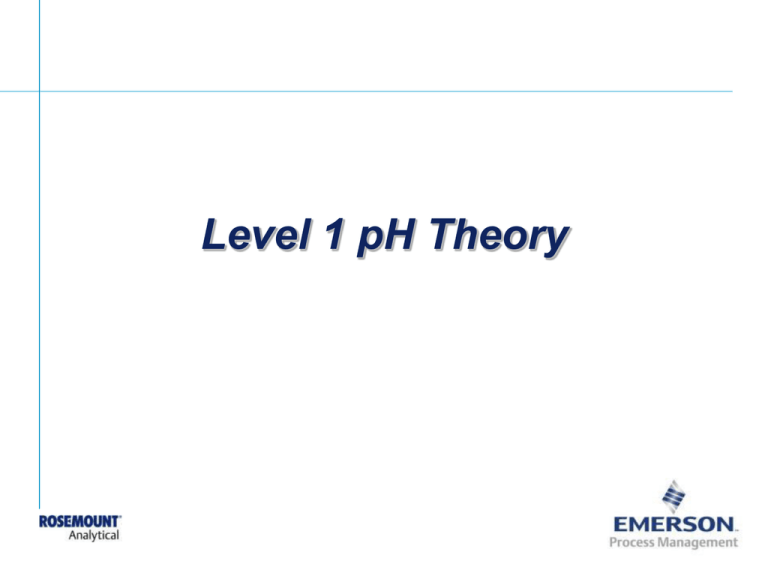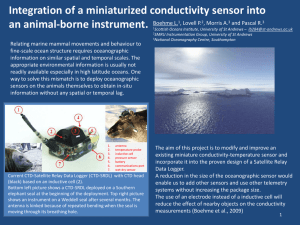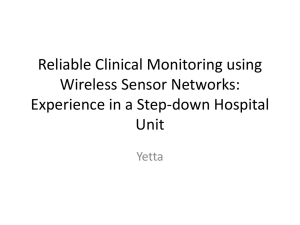Level 2 pH Training - Emerson Process Management
advertisement

Level 1 pH Theory Section 1 What is pH and How is it Measured? Why Measure pH? Final product quality depends on pH. – Pharmaceutical – Paper – Metal plating – Drinking water – Food and Beverages – Alternative fuel Chemical reaction rates are often a function of pH – Corrosion – Scaling – Precipitation (salts) – Fermentation Environmental Monitoring Acid and Base Basics Strong Acids dissociate completely in water releasing hydrogen ions. HCl H+ + Cl- Weak Acids only partially dissociate in water releasing hydrogen ions. HAc H+ + Ac- Strong Bases dissociate completely in water releasing hydroxyl ions. NaOH Weak Bases only partially dissociate in water releasing hydroxyl ions. NH4OH Water itself partially dissociates releasing hydrogen and hydroxyl ions. There is an equilibrium in water between hydrogen and hydroxyl ions. H 2O Na+ + OHNH4+ + OH- H+ + OH- What is pH? pH = - log [aH+] or aH+=10-pH aH+ = g cH+ pH is the “unit of measure” for the acidity of a solution. It is defined as the negative logarithm of the hydrogen ion activity,aH+ Activity is related to the concentration of Hydrogen Ion, H+ by an activity coefficient. In general, pH is used as the measure of acidity and rarely used as a direct measurement of concentration by users. pH Scale •pH scale is based on dissociation constant of water Kw •Kw = aH+aOH- = 10-7·10-7 = 10-14 mol/liter at 25°C (and ONLY at 25°C) pH Hydrogen Ion [H+] Hydroxyl Ion [OH-] 0 Acidic 1 2 3 4 5 6 7 Neutral 8 9 10 11 12 13 14 Basic 1.0 0.1 0.01 0.001 0.0001 0.00001 0.000001 0.0000001 0.00000001 0.000000001 0.0000000001 0.00000000001 0.000000000001 0.0000000000001 0.00000000000001 0.00000000000001 0.0000000000001 0.000000000001 0.00000000001 0.0000000001 0.000000001 0.00000001 0.0000001 0.000001 0.00001 0.0001 0.001 0.01 0.1 1.0 pH values of everyday solutions pH 0 pH 1 pH 2.3 pH 3 pH 4.3-4 pH 4.8 pH 6.5 pH 7 pH 7.36 pH 8.3 pH 13 pH 14 Sulfuric Acid (Battery Acid) Gastric Juice, 0.5% Sulfuric Acid Lemon Juice Vinegar, Coca Cola Beer, Sour Milk Pure water air equilibrated Fresh Milk Pure Water Blood Sea Water 0.4 % NaOH NaOH (Drain Opener) Key pH Sensor Components Measuring Electrode – Develops a millivolt potential directly proportional to pH in an aqueous solution Reference Electrode – Maintains a stable reference potential regardless of changes in solution pH or other ionic activity Reference Electrode Liquid Junction – Maintains electrical contact between the pH measuring electrode and the reference cell via the process solution Temperature Compensator – Corrects for changes in the millivolt output of the pH sensor due to process temperature change pH-Glass Electrode Shield Glass Body The purpose of a pH glass electrode is to develop a millivolt potential directly proportional to pH of an aqueous solution Ag/AgCl Internal Wire pH Sensitive Glass Buffered Fill Solution The Reference Electrode Glass Body Ag/AgCl Internal Wire KCl Fill Solution Liquid Junction pH17 The purpose of the reference electrode is to provide stable and reproducible potential to which glass electrode potential may be referenced. It completes the circuit by contacting the sample solution through a liquid junction. The liquid junction allows diffusion of the electrolytes (ions) into and from the process, to maintain electrolytic contact. Most reference electrodes are termed ‘non-flowing’, because contact with the process is by ionic diffusion and not flow of the filling solution. Liquid Junctions Liquid Junction – A porous plug that allows liquid contact between the internal KCl solution and outside process solution but restricts the flow. – The larger the porosity is, the lower the electrical resistance is and higher the diffusion rate is. – The smaller the porosity is, the higher the electrical resistance is and the lower the diffusion rate. There is a tradeoff between high flow with good measurement accuracy, and low flow with longer reference life and less stable junction potentials. Potassium and Chloride ions diffuse out the reference at the essentially same rate. – Positive and negative Ions in the process can diffuse into the reference at different rates, which leads to a build up of an electric charge across the liquid junction. – This is called Liquid Junction Potential, which normally causes a small error in the pH measurement, which can be calibrated out by standardization KCl Diffusion Rate 5K ohms 6-8 month life KCl Diffusion Rate 20K ohms 1-2 year life pH Sensor Construction Basic circuits for a pH measurement Sensor Potential (E) using a pH sensor with a Solution Ground. E = (EpH - ESG) – (ERef – ESG) A solution ground makes it possible to measure reference electrode impedance and use reference impedance as a diagnostic tool. ESG Temp EpH ERef Sensor Potential (E) using a pH sensor without a Solution Ground. E = EpH – ERef Temp EpH ERef Preamplification pH sensor outputs (mV) are high impedance signals and can be susceptible to noise and interference. Preamp – To lower the impedance and amplify the signal, a preamplifier is used: • In the pH sensor • In a remote junction box • In the transmitter Preamp Preamp Certain (rare) pH sensors use a 2nd glass electrode as a reference. – Most pH transmitters can be configured to accommodate the high reference impedance of these sensors. Temperature Compensation and the Calculation of pH The effect of temperature on the pH sensor must be taken into account when determining pH to avoid large errors. How pH is Calculated with Temperature Compensation: Sensor potential (mV) Isopotential pH Zero offset (mV) Temperature (K) Slope (mV/pH K) pH Changes with Temperature Change in Strong Acid and Base Solutions The pH of certain solutions can themselves change with temperature. The degree to which this happens is a function of the composition of the solution. In application where this is an issue, a second, solution temperature compensation is provided to correct the measured pH to 25 C. Solution pH Change with Temperature pH 9.00 8.90 8.80 8.70 8.60 8.50 8.40 SOLUTION pH CHANGE OF A DETERGENT WITH TEMPERATURE Solution Temp. Coefficient o o Z= -.0242 pH/°C o o o 8.30 8.20 8.10 8.00 o o 20 25 30 35 40 45 50 55 pH Transmitter Configuration All the Configuration Needed for pH Measurements Location of Preamp Impedance of Reference Electrode (can choose High for special electrodes) Temp Comp On/Off Temp Unit Manual Temp Value Solution Temp Type Coefficient for Linear Solution Temp Comp Isopotential pH (can be changed for special electrodes) Mounting pH Sensors pH Sensors should be mounted at least 10 degrees above horizontal. Otherwise, the air bubble in the glass electrode can cover the inner surface of the glass bulb. Section 1 Test Question 1 pH is proportional to: a) The concentration of hydrogen ion b) The concentration of hydroxyl ion c) The logarithm of the concentration of hydrogen ion d) The negative logarithm of the concentration of hydrogen ion Question 2 A neutral solution has an equal concentration of hydrogen and hydroxyl ions and its pH: a) is always 7.00 pH b) is only 7.00 pH at 25 deg C c) depends on the temperature of the solution d) b and c Question 3 The millivolt output of a pH sensor: a) changes with temperature b) remains constant with temperature changes c) can be easily compensated for by measuring temperature d) a and c Question 4 The actual pH of a solution can: a) change with temperature b) change with temperature and does not require special temperature compensation c) can be compensated by using special temperature compensation d) a and c Question 5 pH sensors must be mounted at least 10 degrees above horizontal. – True or False? Answers to Section 1 Test 1 – d: pH is proportional to the negative logarithm of hydrogen ion concentration 2 – b and c: The pH of a neutral solution changes with temperature and is only 7.00 pH at 25C 3 – a and c: The millivolt output of a pH sensor changes with temperature and can easily be compensated for by measuring temperature 4 – a and c: The actual pH of a solution can change and can be compensated by using special temperature compensation 5 – True: pH sensor need to be mounted 10 degrees above horizontal Section 2 When to Use pH and Special pH Applications When to Use pH -- Acidic Solutions At pH values below 1.0 pH, a bad pH application becomes a good Conductivity application. Conductivity (microS/cm) 1,000,000 100,000 10,000 pH vs Conductivity for a Strong Acid 100 ppm Acid 4% Acid 1,000 100 10 1 -1.0 1 ppm Acid 1% Acid 0.0 1.0 Less Than 0.0 pH Not Possible w ith pH 2.0 3.0 Acid Error Below 1.0 pH 4.0 5.0 pH When to use pH -- Basic Solutions At pH values above 13.0 pH, a bad pH application becomes a good Conductivity application. pH vs Conductivity for a Strong Base Conductivity microS/cm 4% Base 10% Base 1,000,000 100 ppm Base 100,000 10,000 1 ppm Base 1,000 100 Large Sodium Error 10 pH Electrode Destroyed 1 9.0 10.0 11.0 12.0 pH 13.0 14.0 15.0 Special pH Applications Special pH Applications Most pH applications involve weak solutions or simply water at near room temperature. – A general purpose pH sensor can be used • The sensor should have a long, worry free life In some pH applications, the temperature, pressure, and composition of the process can create issues with the pH measurement – pH sensors with special features need to be chosen to best deal with these issues Pure Water (Conductivity < 5 mS/cm) Liquid Junction Potential (LJP) – In normal applications, a potential at the liquid junction of the reference electrode is set up by the unequal diffusion of ions from the process into liquid junction. • This is usually no more than 15 to 20 mV (~ + 0.3 pH) and can be calibrated out by standardization. In high purity water application this effect can become large and unstable resulting in major errors and drifting. – This can be made worse by fluctuations in flow and static buildup on the pH sensor due to the low conductivity of the water. Pure water pH applications need a special sensor designed to take these effects into account. High Purity Water pH System Components 500 ml Electrolyte Reservoir Vent Tube Reservoir Filter Reference Tubing Air Bleed Screw Combination Electrode Sample OUT Diffuser (inside flow cell) Sample IN Flow Cell High Temperature Applications High Temperature Traditional pH Sensor Lifetime versus Temperature – Accelerates the ageing of pH sensor materials. – Increases the impedance of the glass electrode. • Results in a slower response time. – Can quickly destroy a pH sensor not designed for it. – A pH Sensor designed for High Temperature must be used. Current High Temperature pH Sensor Ratings •Sensor 1: Up to 155°C at 400 psig Process Effects on Glass Electrodes Chemical Erosion and Attack – Hydrofluoric Acid (HF) • Dissolves glass – If fluoride is present you need to know its concentration and the pH range. » A special sensor may be needed or the application may not be possible with pH. – Sodium and Potassium Hydroxide (NaOH and KOH) • > 4 % (14 pH) will dissolve glass within 8 hours at elevated temperature – there’s no remedy -- go with conductivity – Solutions containing Abrasives • To prevent electrode damage or breakage, protect the electrode from the direct impact of the process flow. – Glass electrodes crack or break in these cases. Sensor Coating A sample velocity > 5 ft/sec will help minimize coating Cleaning Solutions for: – Alkaline or Scale • 5 % HCl or vinegar – Acidic Coatings • Weak caustic < 4 % – Oil, grease, or organic compounds • Detergent / sensor friendly solvents Use a pH Sensor designed to resist coating In line Cleaning can be done using a jet spray cleaner. Coating increases sensor response time and can cause instability in pH control applications. – Severe coating shuts down the pH measurement altogether. Reference Electrode Contamination Plugging – Precipitation of silver in the reference fill solution by ions in process. • Typical villains are sulfide, bromide, and iodide ions • Use a triple junction electrode with a potassium nitrate outer fill. • Plugging causes the pH measurement to drift. Poisoning – Depletion of the silver in the reference solution by precipitation or complexation of free silver ion. • Precipitation: sulfide, bromide, and iodide • Complexation: ammonia; cyanide is deadly to references • Check the concentration of poisoning ions and use a triple junction electrode, or in extreme cases, a special electrode will be needed. • Poisoning causes a large zero offset (> 60 mV). What Happens During Reference Cell Poisoning Reference Poisoning can be a slow process. Nothing happens until the silver ion concentration in the reference is irreversibly depleted and the potential changes. Reference Potential, mV Time Reference 3: OK Reference 1: Poisoned Reference 2: Poisoned Triple Junction Reference Electrode Reference technology – Single, Double, Triple Junction are used. • Triple junctions slow the diffusion of harmful ions into the innermost portion of the reference. Reference electrode material – Silver-silver chloride wire in potassium chloride solution • Standard concentrations of silver and chloride ions maintain a standard potential • Poisoning ions disrupt these concentrations Junction Materials – Ceramic, Teflon, quartz fibers Electrolyte Fill Solutions – Gelled fill solution – Resists the transport of harmful ions by thermal convection Liquid Junctions Applying pH – You need Information: – Process Pressure and Temperature • Don’t forget to include transients—a short expose to high temperature or pressure can kill a sensor not designed for it. – Process Composition • Not such a concern in common, well-known applications. • In certain applications, knowing the process composition is essential. – Choose the Sensor for Application • In benign applications go with a sensor easy to mount and maintain • Specially Designed pH Sensors are needed for: – – – – High Purity Water High Temperature Processes Processes that Coat Process with components that Poison Section 2 Test Question 1 Conductivity is a better measurement than pH for concentrated acids and bases. – True or False? Question 2 Measuring pH of a solution with a conductivity less than 5mS/cm can requires a special pH sensor. – True or False? Question 3 When choosing a pH Sensor the following should be considered: a) Process temperature and pressure b) The conductivity of the process c) The composition of the process d) All of the above Question 4 A process flow velocity greater than 5 ft/second will help minimize sensor coating. – True or False? Question 5 pH measurements in processes with high temperature and pressure require a special pH sensor. – True or False? Answers to Section 2 Test 1 – True: Conductivity is a better measurement of concentrated acids and bases, due to problems with pH in these solutions. 2 – True: Measuring the pH low conductivity solutions requires a special pH sensor. 3 – d: The temperature, pressure, and composition of a process, including transients needs to be considered when applying pH. 4 – True: a high sample velocity does help prevent sensor coating. 5 – True: High sample temperatures and pressures require a special pH sensors; standard pH sensors have a short life in these applications. pH Calibration and Diagnostics pH Buffer Solutions Solutions of known pH that can withstand moderate contamination or dilution without significant pH variation. The more concentrated a buffer solution is the more resistant it is to dilution and acid or base contamination. Buffers 4 and 7 or 10 are usually used – a difference of 3 pH between buffer values is recommended for (two point) buffer calibrations Rules of buffering – Use fresh buffer – Rinse between buffers – Allow reading to stabilize The of a buffer solution can and does change with temperature – This needs to be taken into account during a buffer calibration pH Buffer Calibration – Verifies Sensor Response to pH Change 14 12 10 – Determines Slope and Zero Offset Buffer 2 8 Zero 6 4 Buffer 1 2 Slope mV/pH 14 12 10 8 6 4 2 0 0 Two Point Calibration Transmitter Automatic Buffer Calibration Features – Identifies the Buffer Value – Compensates for Changes in Buffer pH with Temperature – Accepts Calibration only upon Stabilization of the Millivolt Signal pH Standardization Performed on-line by grab sample evaluation – Use a calibrated portable analyzer – Take sample at the or near the sensor installation point – Analyze grab sample immediately for best results Calibrates the sensor in the process environment – Compensates for minor coatings – Compensates for small offsets due to liquid junction potential But…Even a broken pH electrode can be standardized. Configuring pH Calibration The current live measurements and their status Begin Buffer or Temperature Cal or pH Standardization Cal Constants from the last calibration Set the maximum zero offset limit Select: Manual or Auto Buffer Cal Select the buffer type you want to use for Auto Cal Select Stabilization Span and Time pH Diagnostics pH Diagnostic Types Sensor Diagnostics Calibration Diagnostics Transmitter Diagnostics Events Sensor Diagnostics Electrode Impedance Diagnostics Glass Electrode Impedance – Range: 10’s to 100’s of Mohm – Glass impedance is highly temperature dependent and uses impedance temperature compensation. – Best use is detecting cracked or broken electrode (R < 1Mohm) – The pH of a broken or cracked electrode is a constant pH near 7.00 pH. • It can easily go undetected without diagnostics Reference Impedance – Needs a pH sensor with a solution ground for measurement – Range: 1 to 100’s of kohm – Detects plugged or coated reference electrodes With a Solution Ground Without a Solution Ground More Sensor Diagnostics Temperature Diagnostics – High / Low Temperature • Temperature is outside the range of the pH sensor, which can be damaged Sensor potential (mV) – Temperature Open / Shorted • The measured temperature will appear either extremely high or low – The measured pH will be about 7 pH » This error can go undetected without diagnostics Solution Ground Open – The solution ground input is an open circuit • The millivolt input is out of range • The solution ground lead must be connected • The solution ground on the sensor must be in contact with the process solution • If there is no solution ground the solution ground input must be jumpered to the reference electrode input. Temperature A good Temperature measurement is as important as a good Millivolt input. Calibration Diagnostics pH Slope Low – Usual low limit is 40 mV/pH (Ideal slope is 59.19 mV/pH) • • • • Indicates that a pH electrode is worn out The sensor is worn out (usually has a high impedance short) The sensor is coated An error was made during calibration pH Slope High – Usual high limit is 62 mV/pH • There could be a sensor problem – check for instability • An error was made during calibration (most likely) Zero Offset to high – Default setpoint is + 60 mV • Can indicate a poisoned reference electrode • An error was made during calibration Transmitter Diagnostics Electronic Errors – Can be an input out of range (A to D Converter Overrange) • Likely a sensor problem – Can indicate a fatal error (Ground > 10% Off) • Transmitter must be replaced Memory Errors – Usually fatal errors requiring transmitter replacement Events Alerts user and control system that certain events are or have taken place, such as: – – – – Buffer calibration Standardization Temperature standardization Transmitter Out of Service While these events appear on the transmitter’s display, their most important role is in control systems using smart transmitters, where they provide important information in batch and control system records. An Example of pH Diagnostics Sensor Diagnostics Calibration Diagnostics Events Transmitter Diagnostics An Example of a Diagnostic Message in an Asset Management System Smart pH Sensors What Smart pH Sensors Do Smart pH Sensors have a preamplifier with a memory chip Upon connection to a Smart enabled pH Transmitter they upload their latest calibration data, which is used by the transmitter to measure pH – This makes it possible to buffer calibrate a sensor in the shop or laboratory and simply install it in the process. Historical data acquired during calibration is also uploaded to the transmitter for display by it or an asset management system New calibration data and maximum and minimum temperature measured are downloaded from the transmitter to the Smart sensor Smart pH Sensor Information Sensor Information Serial number Manufacturer date code Calibration Data Slope Zero offset Temp cal offset Glass impedance Reference impedance Sensor run time at each calibrations Historical Information Last 5 calibration data sets for troubleshooting Plug and Play Smart Sensor : Basic Sensor Information in an Asset Management System Smart Sensor : Calibration History in an Asset Management System Troubleshooting pH Applications – What do you do when sensors fail prematurely? • Get the application information: – Process temperature and pressure (and transients) – Process composition (and transients) • How is it failing? Broken glass...poisoned reference…coating… • How often is it failing? • What do the diagnostics say? • If calibration information is available, get it • Have sensors always failed in this application or is it a new phenomenon? Troubleshooting pH Applications Tools for diagnosing problems – Use the transmitter’s diagnostics – Smart pH sensors capture calibration data, and min/max temperature; this is very useful for troubleshooting. – If asset management software is used, there is a lot of information captured an audit trail. – Data Logging • Look at measurement data, including temperature, millivolts, and impedances if they are available • Check events, such as diagnostics alarms, if they are also recorded. Section 3 Test Question 1 A two point buffer calibration is the only way to tell if a glass electrode is adequately responding to changes in pH. – True or False? Question 2 If a glass pH electrode is broken, can it be standardized? – Yes or No? Question 3 When choosing a pH Sensor the following should be considered: a) Process temperature and pressure b) The conductivity of the process c) The composition of the process d) All of the above Question 2 The pH of a solution can change with temperature. – True or False? Question 5 When pH sensors consistently fail prematurely, the following should be considered and examined: a) b) c) d) Process temperature and pressure Sensor or calibration diagnostic history The composition of the process All of the above









